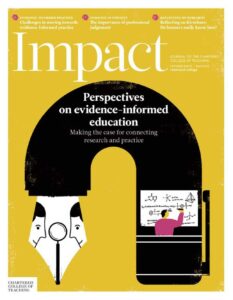The importance of randomised controlled trials in education

I want to see — as I am sure do you — an education system that supports every single pupil to flourish, no matter who they are or where they come from.
Yet, too often, we see similar pupils achieve very different results, even within the same schools. It is usually the poorest pupils — those who can’t afford the same out-of-school support that their better-off classmates can — who lose out.
The stakes are too high for this to be acceptable any more. If we want to improve outcomes for all students, and increase professional independence, we have to support all teachers to become more evidence-informed. That means making good use of what is already known about effective practice and investing our energy into learning more.
This may sound like stating the obvious, but it isn’t just a matter of observing what happens in good schools, labelling it ‘best practice’, and strong-arming everyone into doing it. Schools and classrooms are complex systems, and within them it is very hard to distinguish cause from effect. What is required is sound research to determine causal relationships between teaching strategies and pupil progress.
This is where randomised controlled trials (RCTs) have such an important role to play. They enable us to test out high-promising ideas in the real world of the classroom, giving us a robust estimate of the impact of a programme by comparing the outcomes of students who received it with a control group of students who didn’t. They are the best way of providing useful, comparable results that answer questions that time-poor heads and teachers care about.
Such trials have been commonplace in medicine for the past 60 years. Evidence from RCTs — and, even better, meta-analyses of RCTs, which combine findings from multiple studies — gives doctors and medical professionals the information they need to make informed decisions and to do their job to the best of their professional ability.
As patients, we assume doctors are making decisions about our treatment based on the best available evidence (rather than on a whim). Because of this we’re reassured that we should have pretty much the same chance of getting better no matter which doctor we see. And we’d consider it absurd if a doctor decided to try out an untested treatment on a patient without its effectiveness first being properly demonstrated through a trial.
Six years’ ago, randomised trials were almost unheard of in education in this country. Since 2011, the Education Endowment Foundation (EEF), the organisation that I lead, has committed funding for rigorous and independent evaluations of over 130 different programmes: 10 per cent of all known trials in education.
Perhaps the most significant figure is this: more than one-quarter of state-funded schools in England are, or have been, involved in a trial funded by the EEF. We now know that large-scale, robust, quantitative trials of programmes in schools are possible.
In my view, this is one of the biggest leaps forward our education system has made in the past 30 years. In our drive to raise academic standards in an era of tightening funding and concern about teacher workloads, high-quality evidence is the most useful tool we have to support schools to make decisions about how best to use their resources.
The evidence generated by robust trials means teachers today are in a much better position to judge what is likely to work and not work in their classroom than they were even a few years ago. There’s now a massive appetite for clear and actionable evidence across the teaching profession. Not only have teachers embraced research, they are actively calling for more.
But an evidence-informed education profession isn’t just about testing new interventions. It can also help us make best use of the resources already available to us. The deployment of teaching assistants is a very pertinent example.
Each year our schools spend £5 billion — more than we spend on either roads or housing — employing some 350,000 teaching assistants. Yet previous research told us that many schools struggled to train and support teaching assistants in ways that benefit pupils. Teaching assistants were often assigned to struggling pupils (who are disproportionately from low-income households) to give them more individual attention; but what this meant was that the least experienced adult in the classroom was trying to help those with the greatest learning needs. Unsurprisingly, this approach was often associated with a negative impact on the learning of those already-struggling pupils.
To find out how schools can make best use of their teaching assistants, the EEF has funded several RCTs that focus on improving their deployment. To date, seven of these have shown that when trained to deliver structured one-on-one or small-group interventions, teaching assistants can typically boost their students’ learning by an additional three months.
Such strong evidence from well-run RCTs gives us confidence in the results, but that is just the beginning of engagement with evidence. We know that running robust evaluations of educational innovations is only half the challenge; in the busy, plate-spinning world of schools, helping teachers to act upon the findings in a consistent and replicable way is equally complex. Our next big challenge is to mobilise the evidence we have for the maximum benefit of our young people.
RCTs are not, of course, a panacea; the evidence they generate does not act as a substitute for professional judgement, which should continue to play a significant role. We can return to health for a useful comparison. Large-scale trials are used to determine whether drugs should be licensed and to provide doctors with the information they require to make prescriptions. Then, the doctor (and patient) will determine whether or not the treatment is having the desired effect, and if it isn’t, they will adjust the treatment or try another approach.
Randomised trials are rarely perfect, but they are currently the best way we know of generating reliable evidence that teachers can consistently use to enable us to improve the education of disadvantaged children, no matter which school they attend.










